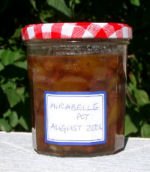
Little did I think...
One of the walks I regularly take with the dogs follows the path known as "Le Chemin des Deux Eglises" - a grass track that winds up between back gardens of the old town houses, from the socalled "new church" to the older one up the hill. On either side are the regimented plots lovingly tended by the local inhabitants: tomatoes hanging in rich red clusters, lettuces standing smug as little maids from school, courgettes gently swelling against the weedfree earth.
In corners of the gardens, or in miniature orchards, are fruit trees, producing plums, apples, figs and quinces. As the summer moves into autumn, and the light changes from the harsh metal of June and July to the softer gold of September, these trees start to yield their crops. It's the moment when the village ladies, broadhipped and heavy-bosomed, get out their large aluminium pans and the carefully stored jars, buy large packs of sugar and get down to making their annual supply of jam.
Some people say that it's just as cheap to buy your jam in the local supermarket as to make it yourself. But they're missing the point. The taste of jam made from your own produce is second to none.
One of the bonuses of living in the Dordogne is that these fruit-trees produce far more than some of their owners can cope with. As a result, people coming to dinner come laden with bags of apples, plums and walnuts. You can't let it go to waste!
Little did I think that I'd become a fan of jam-making. But it's a highly contagious disease, and I think I may have caught it. When I was given a large bag of mirabelles the other day I decided that I needed to do something with the pan I'd bought in the market on impulse some weeks before. The result exceeded my wildest expectations.
Mirabelles are little golden plums of incredible sweetness, delicious in a compote and amazing in the following recipe, which I adapted from a similar one from the Women's Institute, which uses plums. It's not really a jam, though we spread it on bread very happily. You could also eat a dollop of it with vanilla ice-cream - washed down, perhaps, with a glass of the local Monbazillac. Jam's a step further on, with all the business of setting point, pectin etc. But for a first step in the process of learning the joys of jam-making this is as good as any!
Mirabelles Jam

Ingredients
1.3 kg mirabelles, washed, cut in half and stoned
450g sultanas
2 large oranges, peeled, sliced and chopped into small pieces
1.3 kg sugar
Put all the ingredients into a large glass or china bowl and stir together. Cover and leave for about eight hours, or overnight. Then transfer the mixture to a large preserving pan and heat slowly until the sugar is dissolved, stirring slowly. Bring to the boil and simmer until the mixture is fairly thick - at least 30 minutes. If scum appears on the surface, skim it off with a slatted spoon. While the mixture is cooking, sterilise half a dozen jamjars and let them cool. Then pour the gooey mix into the cooled jars and seal.
Click on Link:
Chateau Lalinde : The perfect venue for your event
TAGS: Events Rent a chateau France
Chateau
Perigord Food Holidays in France Recipes








